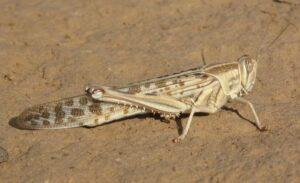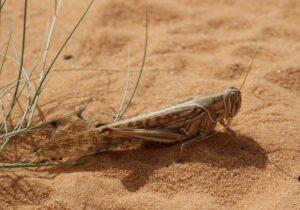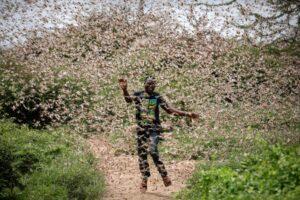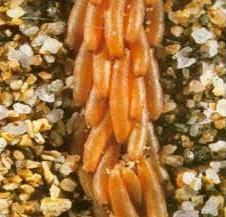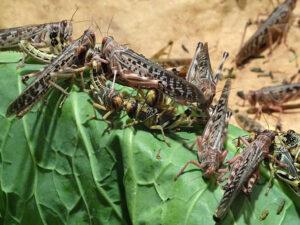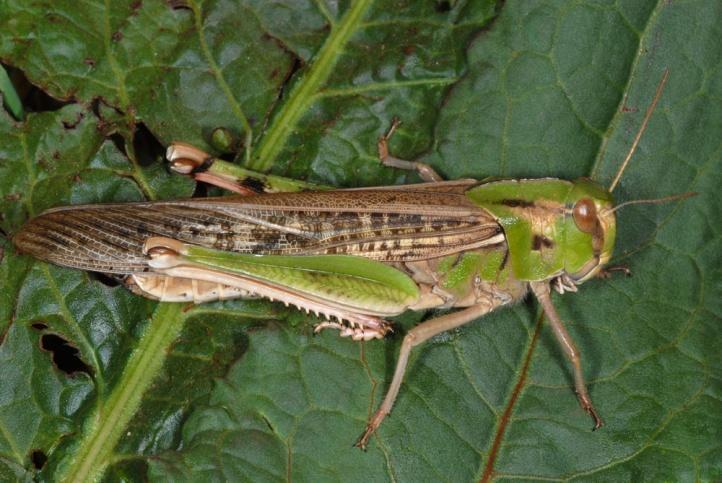Desert Locust (Schistocerca gregaria)
Updated on
28/10/2022The desert locust is a short-horned grasshopper that swarms periodically. It is the most dangerous of all locust pests due to the ability of the swarms to fly large distances causing major loss of crops, pastureland, vegetation, and food. It leads to food insecurity in many countries that are very difficult to recover from.
Scientific Classification
- Class:Insecta
- Order:Orthoptera
- Suborder:Caelifera
- Family:Acrididae
- Subfamily:Cyrtacanthacridinae
- Tribe: Cyrtacanthacridini
- Genus: Schistocerca
- Species: S. gregaria
Conservation Status
Description
In the solitary phase, desert locusts are greenish in early instars and grayish when they are older adults. In the gregarious phase, they are pinkish in early instars and yellow when they reach adulthood with black patterns. It periodically changes the shape of its body, behavior, and reproduction rate in response to environmental conditions like the abundance of moisture and rainfall.
During dry weather, the solitary locusts are forced to stay together in patchy areas with residual vegetation. The sudden crowding releases a happiness chemical in their brains, making them more sociable, promoting rapid movements, and changing their appetite. When the rainy season arrives, the presence of moist soil and ample vegetation causes them to multiply rapidly, further increasing the crowding. At this time, the pests completely change their lifestyle from solitary to group form. In this gregarious phase, they can change their color and shape and increase their endurance levels and brain size.
Distribution: Eastern and northern Africa, southwest Asia and Arabia. It spreads to parts of southern Italy, western Spain, and northern India during population surges.
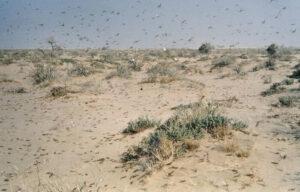
Habitat: Dry areas and deserts.
Do They Bite/Sting: No.
Lifespan: They live for around 3-5 months. But the lifespan varies depending on ecological conditions and the weather.
Predators: Predatory wasps, flies, parasitoid wasps, predatory beetle larvae, reptiles, and birds.
Behavior and Characteristics
Diet
They eat almost their entire body weight (0.07 oz) of green vegetation daily. They can consume various food like leaves, flowers, fruits, shoots, stems, seeds, and barks. All crop and non-crop plants form their diet, including maize, pearl millet, barley, sorghum, rice, sugarcane, cotton, pasture grasses, fruit trees, vegetables, weeds, and date palms.
During plague years, these insects cause widespread damage to crops as they are very mobile and feed on green vegetation like pasture, crops, and fodder. Even a small swarm of 1 sq km can eat the same amount of food as 35,000 people in a day. This is the reason why desert locusts are devastating to agriculture.
Swarming
The body of the desert locust periodically changes in response to the environment over several generations. So it may change from a solitary, highly fertile, shorter-winged, non-migratory form into a long-winged, gregarious, migratory phase when they travel long distances, invading new territories. They have 2-5 generations in a year, and their population can grow 10 to 16 times in each generation. Thus, in some years, they form locust plagues in some areas, consuming all the vegetation and crops, while in others, they live unnoticed in small areas.
A typical swarm can have 150 million locusts per sq km, and flying in the direction of the wind can travel up to 150 km in a day. It can fly up to 6,600 ft above sea level as the temperatures drop significantly at higher altitudes. A pheromone, guaiacol, produced in the gut of the locusts by breaking down plant material, induces swarming by drawing them close together.
Life Cycle
The insect passes through 3 stages of its life, the egg, nymph (hopper), and adult.
1. Egg Stage
The female locust seeks soft soil to lay her eggs. It needs to be at the right temperature and degree of dampness and close to other egg-laying females. She feels the soil with her abdomen and digs a hole into which an egg pod containing up to 100 eggs is deposited. The egg pod is 1.13 in – 1.63 in long, with the lower end being 4 inches below the ground. The eggs are covered by foam that hardens into a membrane plugging the hole above the egg pod.
2. Nymph Stage
The newly hatched nymph starts feeding soon and, if it’s a gregarious individual, forms a group with other hoppers. Both mature and immature individuals are part of the band that feeds, basks, and moves together. Solitary nymphs don’t seek similar types as they remain on their own.
As it grows, it molts when its hard cuticle breaks and its body expands. The new exoskeleton is still soft. The stages between molting are called instars, and the nymph passes through 5 molts before transforming into a winged adult.
3. Adult Stage
After the 5th molt is over, the insect is yet to mature. It is soft and pink at first with drooping wings. Over a few days, the cuticle hardens, and hemolymph is pumped into the wings to stiffen them. If the food supply and weather conditions are suitable, maturation occurs in 2-4 weeks. Otherwise, it may take up to 6 months.
Males mature first, giving off a smell that stimulates maturation in females. On maturing, they turn yellow. Copulation occurs when a mature male hops onto a female and grips her with his legs. The tip of her abdomen receives and stores the sperms that are transferred from the tip of his abdomen. One insemination takes several hours and can produce several batches of eggs. Then the abdomen of the female start to swell with developing eggs.
Getting Rid of Desert Locusts
The primary tool for controlling desert locust infestations is applying small, concentrated doses of insecticides by aerial and vehicle-mounted sprayers at ultra-low volume rates. Biopesticides made using fungi, neem extract, bacteria, and pheromones are as effective as the chemical ones but take longer to act. Preventive measures are undertaken by Government agencies in the affected countries or by specialized regional organizations. Regular monitoring of the weather, ecological conditions, and locust situation can detect early signs of an outbreak.
Farmers often dig trenches to bury hopper bands and try other labor-intensive mechanical ways of killing the pest, which is difficult to implement when it comes to controlling larger populations spread over a vast region. They also make noise and burn tires to scare the swarms away, but that merely shifts them to another nearby location from where they can easily come back.
FAQs
Yes, they are eaten in several countries. They are caught using large nets and boiled, stir-fried, or roasted for immediate consumption or dried for eating later. It is because the notorious insect is rich in protein.
They don’t spend their entire lives in one place. They need moist soil to lay eggs. So they lay a lot of eggs when rainfall arrives in the deserts. When the eggs hatch, they can find ample vegetation to feed on. But as things become too crowded, they migrate in search of food.
The eggs hatch in about two weeks. However, if the weather is not ideal, they can remain buried and dormant for 2-3 months.
Source
parody.fandom.com, cdn.the-scientist.com, reliefweb.int, media.istockphoto.com, aljazeera.com, encrypted-tbn0.gstatic.com




